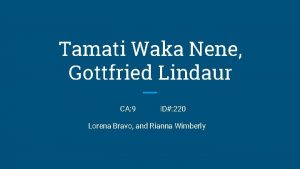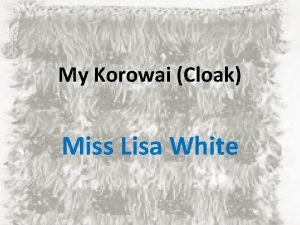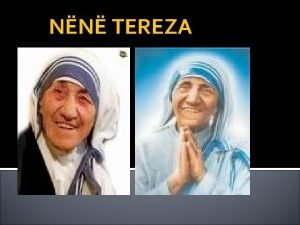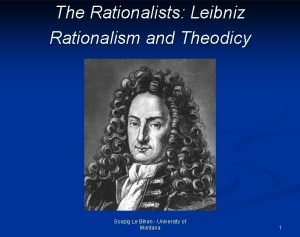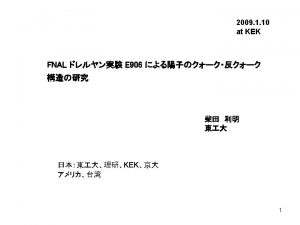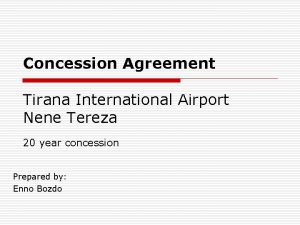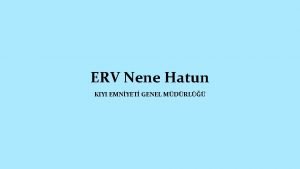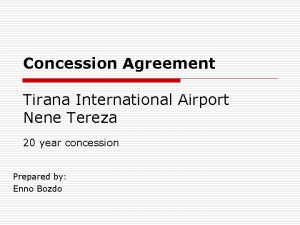Tamati Waka Nene Gottfried Lindaur CA 9 ID










- Slides: 10

Tamati Waka Nene, Gottfried Lindaur CA: 9 ID#: 220 Lorena Bravo, and Rianna Wimberly

Slide ID: Tamati Waka Nene Artist: Gottfried Lindauer Period/Culture: Maori (indigenous people of New Zealand) Date: 1890 C. E. Medium: oil on canvas

Form Line: curved, horizontal, spiral, and wavy Shape: organic shapes, implied shape on face, soft edge shape Space: tamati waka nene is main focus, takes up majority of canvas Color: dark, and muted colors for base of body and most of background. Pop of color but still very neutral on the face and staff. Texture: smooth in appearance Scale/Size: 101. 9 x 84. 2 cm

Image Annotations soft edge shape implied shape on face wavy horizontal The geometric shapes on the face contrast the organic shapes in the overall painting. spiral dark, and muted colors for base of body and most of background. curved organic shapes Pop of color but still very neutral on the face and staff. takes up majority of canvas 101. 9 x 84. 2 cm

Function Use of ancestor portraits in the culture: After a person died, their portrait would be hung on the walls of family homes or in the central building of a community center, to be spoken to, wept over, and cherished by people with genealogical(family)connections to them. In the maori culture paintings such as tamati waka nene functioned as : 1. A way of storytelling and passing down tradition. Providing generational identity to the living. 2. Also, these paintings were to be reverenced and well taken care of. They were not just a representation of tamati waka nene, but more like an embodiment of him.

Content ➔Subject: Tamati Waka Nene was the chief of the Ngati Hao people and also a war leader ➔Symbolism: Nene was like a symbol of strength and war for his people ➔Narration: The painting is a portrait that shows Nene knowingly staring off into the distance, and his facial tattoo and hand weapon adds on to the power and dominance that he gives off

Context ➔ Location: New Zealand ➔ Culture: the Maori people who were considered the indigenous people of New Zealand ➔ Artist: Gottfried Lindauer, who when he arrived to the site was commissioned to paint many portraits on other well-known Maori ➔ Audience: Ngati Hao people ➔ Patronage: Henry Partridge (patron of Lindauer) collected portraits similar to the Nene one and gave them to the Auckland Art Gallery ➔ Modes of display: today displayed at the Auckland Art Gallery, which is considered one of the largest collectors of Lindauer paintings

Related Works and Themes: ➔cultural /ethnic identity ➔Power and authority ➔Narrative Related Work: ➔King Tawhiao Potatau Te Whereowhero, by Gottfried Lindauer

Vocabulary Terms When describing color: Muted- not as bright or colourful as usual Neutral- neutral colours are not very strong or bright Dark- strong and not pale in colour In regards to artwork and culture: Other taonga tuku iho- treasures passed down from ancestors Wharenui- the central building of a community center Wesleyanism- is a Protestant denomination following theology of John Wesleyanism is associated with the Methodist Church. kahu kiwi- a fine cloak covered in kiwi feathers, and an earring of greenstone or pounamu. Tewhatewha- a weapon (which has feathers adorning its blade and a finely carved hand grip with an abalone or paua eye. ) Mana- personal efficacy and status

Sources For description/definition purposes: http: //www. macmillandictionary. com/us/thesaurus-category/british/generalwords-used-to-describe-colours https: //www. sophia. org/tutorials/elements-of-art-space For general research purposes of artwork: https: //www. khanacademy. org/humanities/art-oceania/polynesia/a/tamatiwaka-nene
